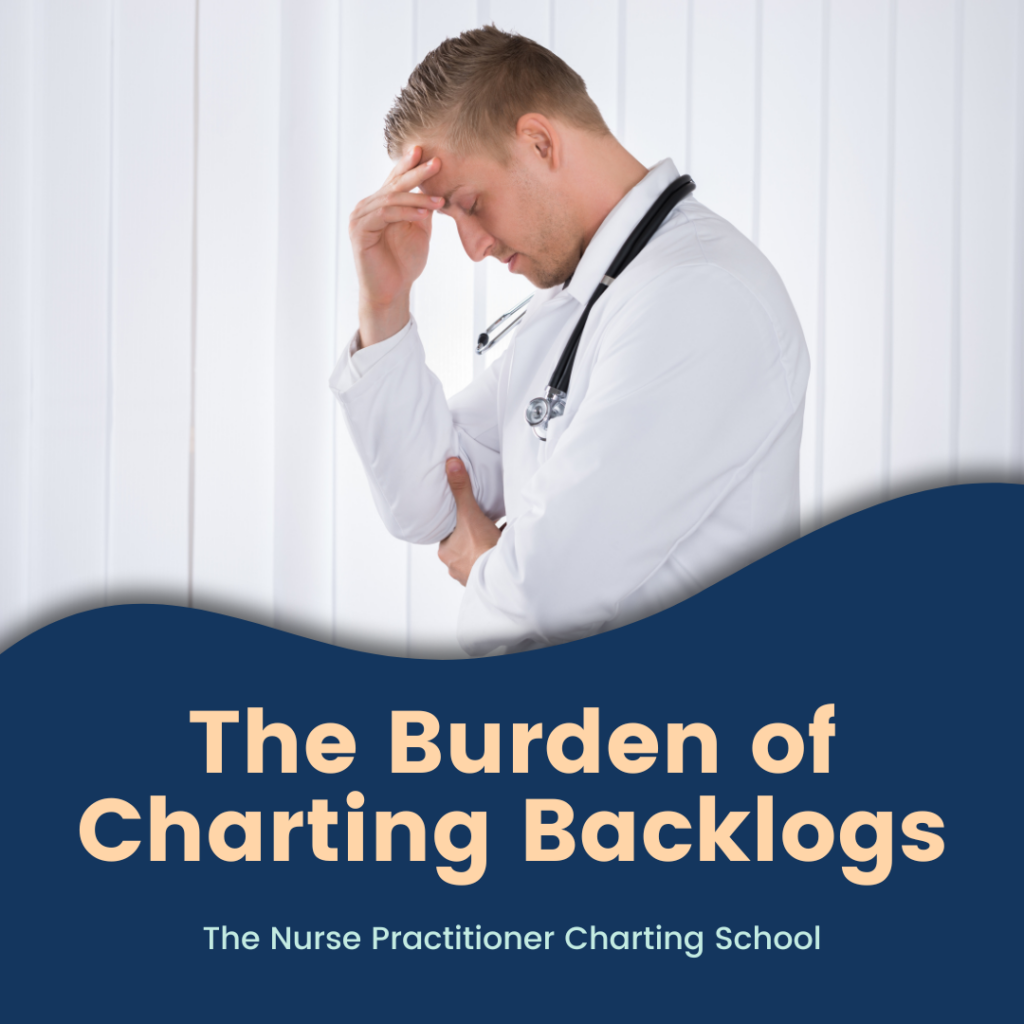The Nurse Practitioner Charting School offers support to nurse practitioners experiencing the burden of charting backlogs. I know you are feeling incredibly overwhelmed. But Erica D the Nurse Practitioner Charting Coach is here to help!
Nurse practitioners are passionate about providing excellent patient-centered care. If we could sit with our patients for hours and educate them on how to improve their overall health we would. Unfortunately, talking with patients is such a small portion of what we do on a daily basis.
Charting is the never ending task that takes time away from truly helping patients. And when we see a large number of patients with 15 minute appointments (sometimes even double booked) it doesn’t take long for the work to pile up. This creates a burden of charting backlogs.
The burden of charting backlogs
Charting backlogs refers to the accumulation of patient chart notes, diagnostic data, prescriptions, and other administrative tasks that nurse practitioners need to complete within the EHR system.
As healthcare technology advances, the shift towards digital records was meant to streamline processes, but it has inadvertently contributed to a heavier workload for nurse practitioners. The need to record details of patient encounters, coupled with the time-consuming “other tasks” (i.e. medication refills, reviewing medical documentation, analyzing diagnostic data, patient messages, etc.), often results in nurse practitioners spending more time in front of screens than with patients.
The increasing burden of electronic health record (EHR) documentation and administrative tasks has led to a growing concern of nurse practitioner burnout. In this blog post, we will explore the insidious effects of charting backlog on nurse practitioners’ well-being, patient care, and healthcare systems.
Effects on nurse practitioners
Dealing with the prolonged burden of charting backlogs can have many negative effects on nurse practitioners. We will take a look at a few of these negative results as related to nurse practitioner burnout.
Emotional exhaustion.
The emotional toll of charting backlog is profound. As APRNs struggle to find time for meaningful patient interactions, they may feel emotionally detached from their role. The empathy and compassion that initially drew them to healthcare can be eroded by the constant pressure to catch up on documentation. This emotional exhaustion caused by the burden of charting backlogs is a sign and symptom of nurse practitioner burnout.
Decreased work-life balance.
The documentation overload can cause nurse practitioners to stay late at the office or bring charts home. This additional time creates a disproportionate work-life balance. The imbalance between work and personal life leaves NPs with limited time for relaxation, family, and self-care. This lack of work-life balance is a significant risk factor for nurse practitioner burnout.
Reduced job satisfaction.
Nurse practitioners enter the healthcare profession to make a positive impact on patients’ lives. However, the burden of charting backlogs detracts from their ability to deliver quality care, leading to reduced job satisfaction and a sense of disillusionment. A charting backlog can make the nurse practitioner begin to loath their job and consider leaving healthcare altogether.
Decrease in productivity.
Nurse practitioners who are constantly overwhelmed with the burden of charting backlogs will see a decrease in overall productivity. When our brains experience information overload, it can cause brain fog. This constant overwhelm alters our alertness and attentiveness, which will decrease productivity.
Not to mention, the time it takes to go back through the open charts and having to try to recall the patient’s history of present illness, review of systems, physical exam, and plan of care takes the nurse practitioner more time and energy to get through.
Negative effects on physical and mental health.
The prolonged hours spent on documentation and administrative tasks can take a toll on nurse practitioners’ physical and mental health. Sitting for extended periods, coupled with the stress of managing a heavy workload, can lead to physical discomfort, musculoskeletal issues, and heightened stress levels.
The burden of charting backlogs creates multiple negative effects on nurse practitioners.
Effects on patient care
Reduced time for patient interaction.
The more time nurse practitioners spend on charting backlogs, the less time they have to engage with patients. Meaningful conversations and building rapport become secondary to the pressure of catching up on documentation. Making a difference in patient’s lives is a reason why many of us went into healthcare. But when NPs experience the burden of charting backlogs, it is hard to have these meaningful visits with patients.
Risk of errors.
The rush to complete documentation can lead to errors in patient records, prescriptions, and treatment plans. It is difficult to recall information days or weeks after seeing the patient. Nurse practitioners may not accurately remember what the patient reported or the correct treatment plan. Inaccurate or incomplete information can compromise patient safety and quality of care.
Delayed diagnosis and treatment.
Charting backlogs can lead to delays in reviewing test results, making accurate diagnoses, and implementing timely treatments. If a patient has been referred to a specialty provider (or vice versa) and there is no signed documentation, it is difficult to truly see the full picture of the patient. Such delays can negatively impact patient outcomes, particularly in cases where early intervention is crucial.
These are just a few of the negative effects on patient care caused by the burden of charting backlogs.
Effects on healthcare systems
High turnover rates.
Nurse practitioner burnout due to the burden of charting backlogs contributes to high turnover rates in healthcare facilities. Many nurse practitioners leave their positions in search of better work environments, leading to disruptions in patient care continuity.
Delay in billing insurance.
Many health insurance companies have deadlines of when a patient encounter can be submitted. Most health insurance companies require claims be submitted within 90 days from date of service. If nurse practitioners have a backlog of charts, they may miss this window for claims to be submitted. This can cause a delay in payment or even a denial from the health insurance companies.
As nurse practitioners, it is our duty to properly code and bill for our services rendered. We need to generate income for the healthcare facility in order for the institution to remain open.
Increased healthcare costs.
Inefficient documentation practices can lead to redundant tests, procedures, and prolonged hospital stays, increasing overall healthcare costs. Furthermore, replacing experienced nurse practitioners who leave due to burnout and training new staff incurs additional expenses.
Negative reputation.
Healthcare facilities struggling with nurse practitioner burnout and subsequent turnover gain a negative reputation among both patients and healthcare professionals. This impacts their ability to attract and retain top talent and maintain patient trust.
The burden of charting backlogs may not be immediately visible, but its impact on nurse practitioners’ well-being, patient care, and healthcare systems is undeniable. To ensure the sustainability of high-quality patient care and the well-being of nurse practitioners, APRNs must prioritize the development of strategies that address and alleviate the burden of charting backlogs.
Only by recognizing and addressing this issue can we create a healthcare environment where nurse practitioners can thrive and provide the exceptional care they are trained to deliver.
*****For more tips on how to tackle the charting backlog, check out this article.
Additional charting resources
For more charting and time management tips, check out The Time Management and Charting Tips Course.
This online, instant access course teaches nurse practitioners the tips and tools to chart accurately and efficiently so you can run on time during your workday, eliminate the overwhelm, leave work on time, and STOP charting at home!
Also check out other articles on The Nurse Practitioner Charting School’s blog page. The NP Charting School was created to be the one stop for all documentation resources created specifically for nurse practitioners!

Erica D the NP is a family nurse practitioner and The Nurse Practitioner Charting Coach. Erica helps nurse practitioners STOP charting at home! Erica created The Nurse Practitioner Charting School to be the one stop for all documentation resources created specifically for nurse practitioners. Learn more at www.npchartingschool.com
Follow on Facebook: The Nurse Practitioner Charting SchoolAnd on Instagram: @npchartingschool
Free training: 4 charting tips to help nurse practitioners get their time back! Sign up here!



